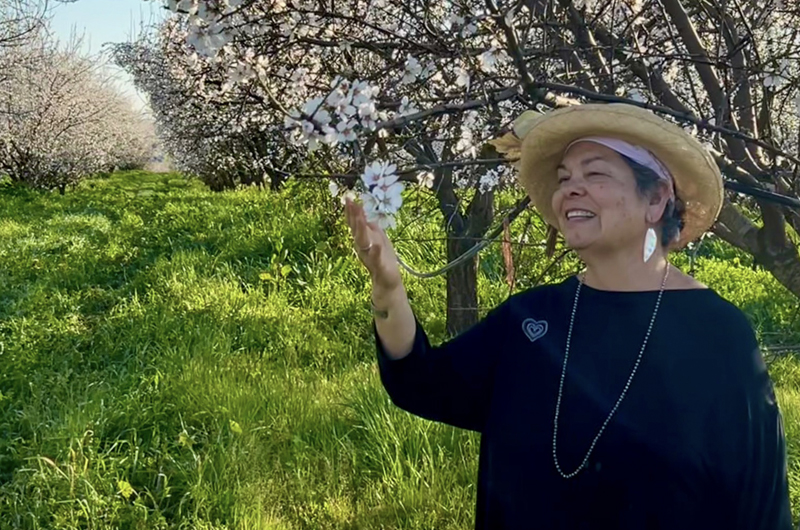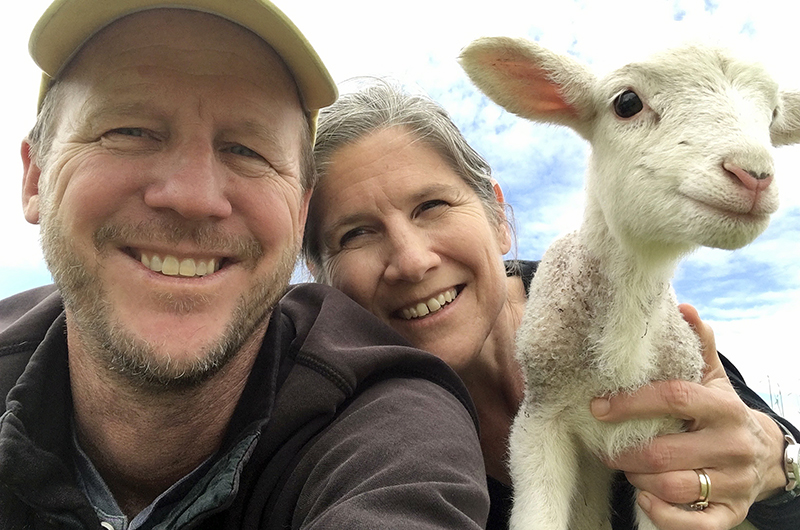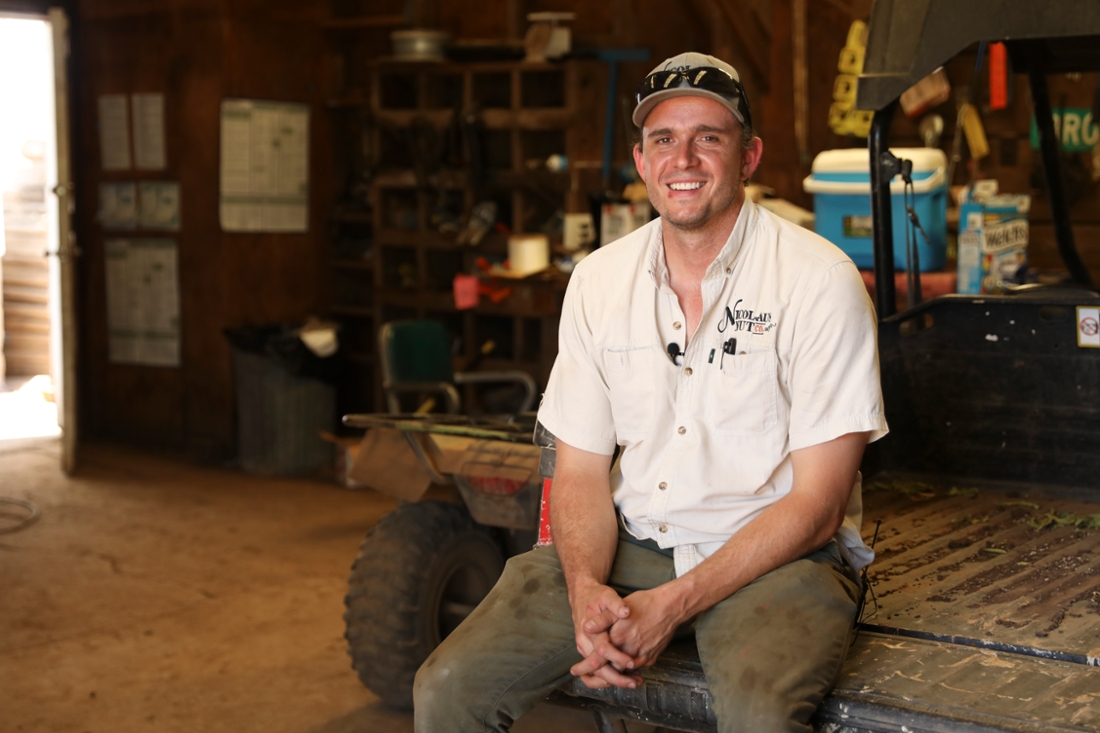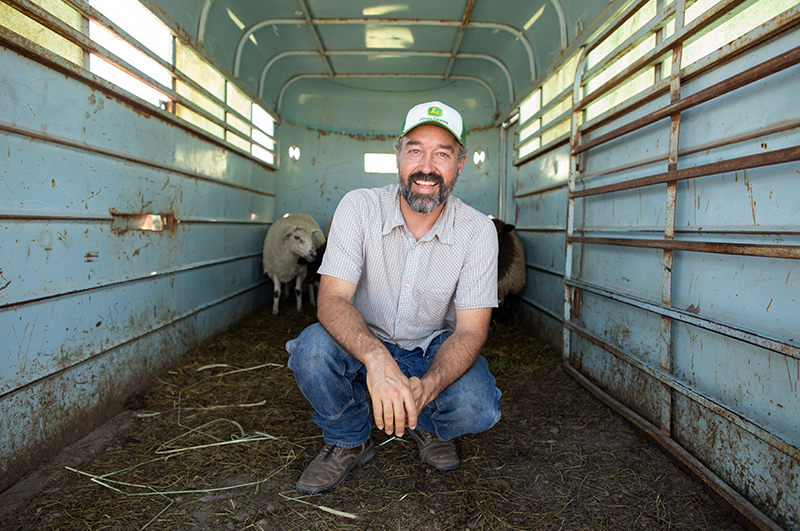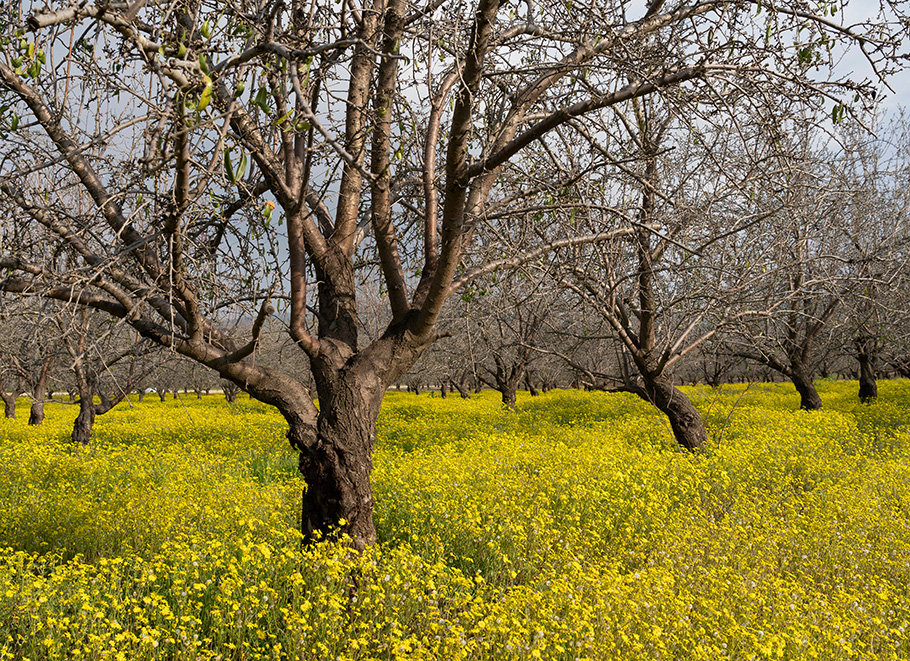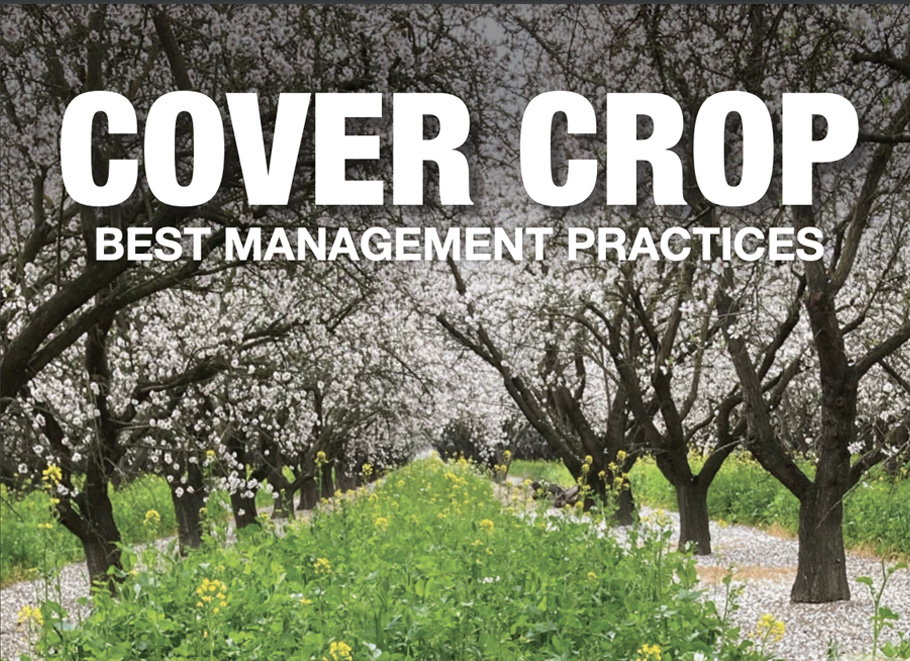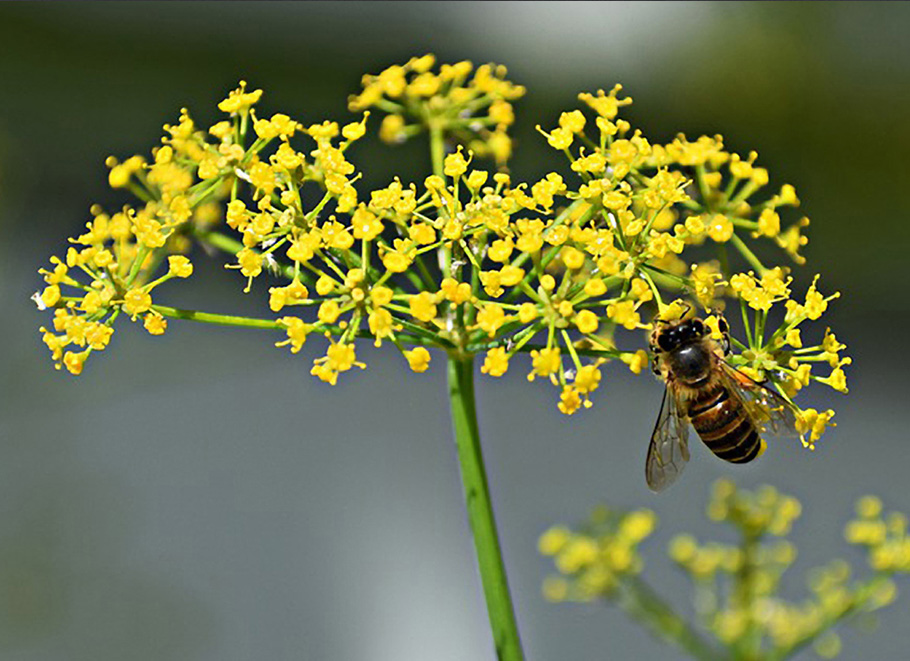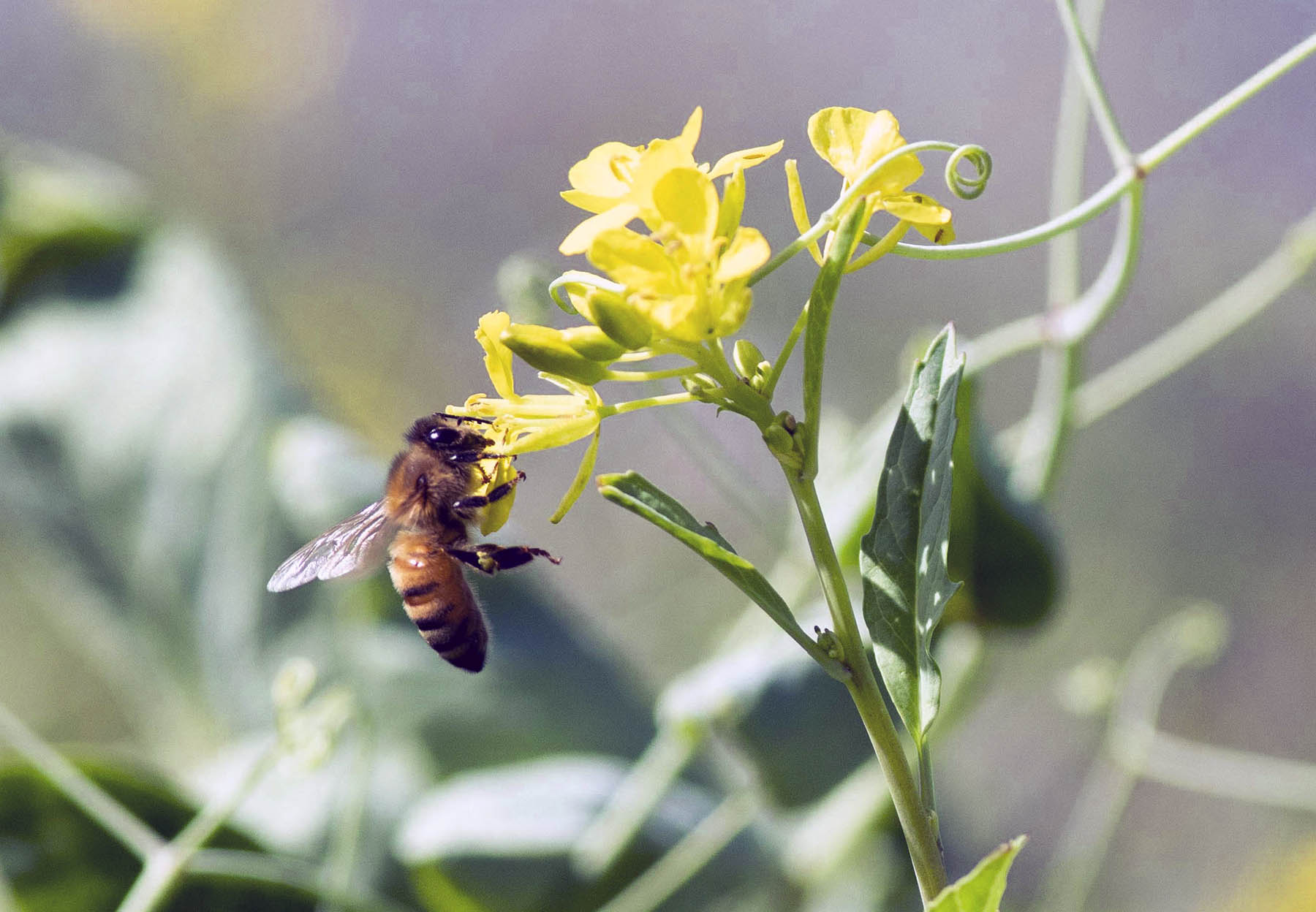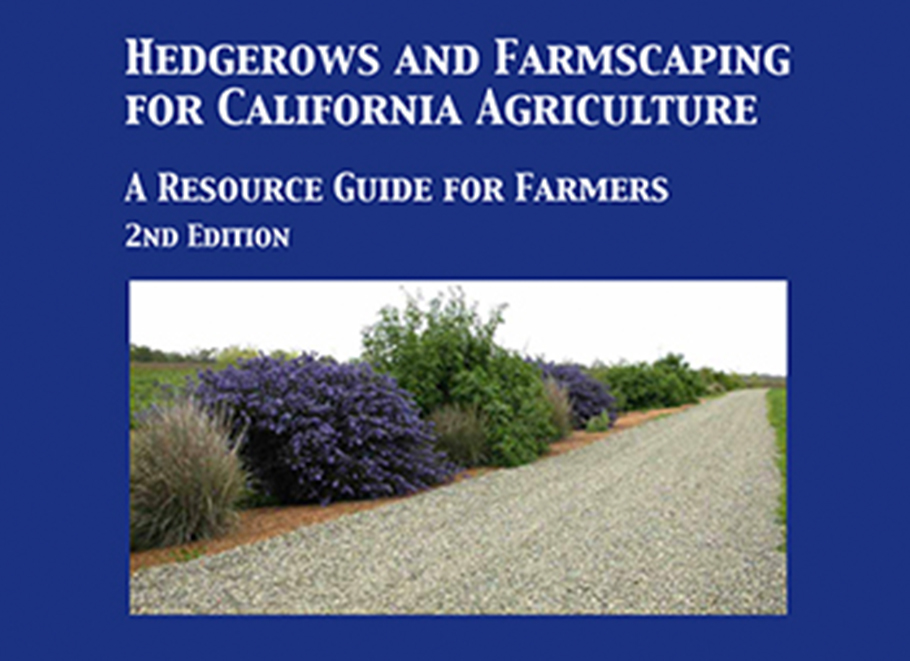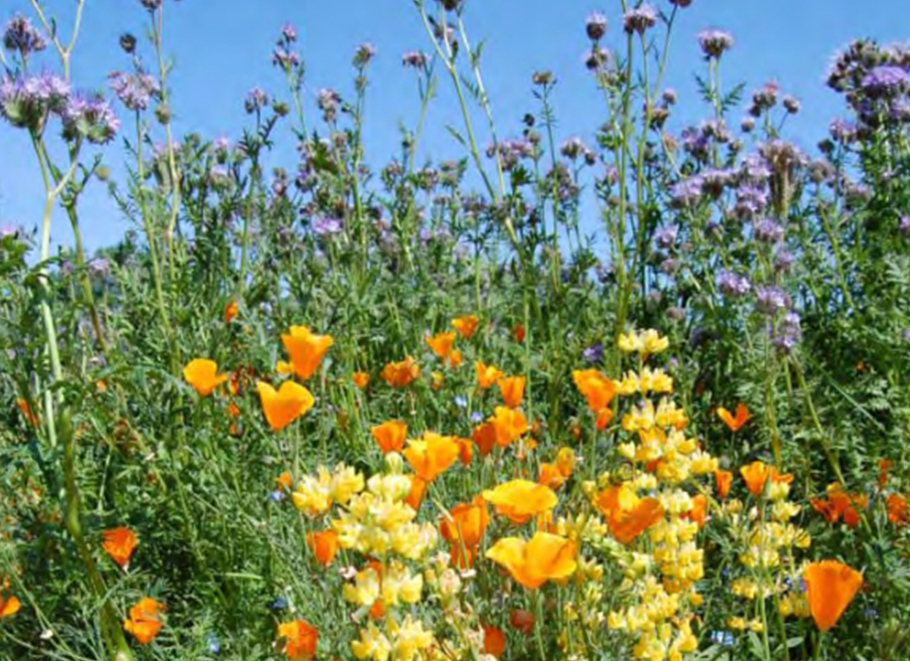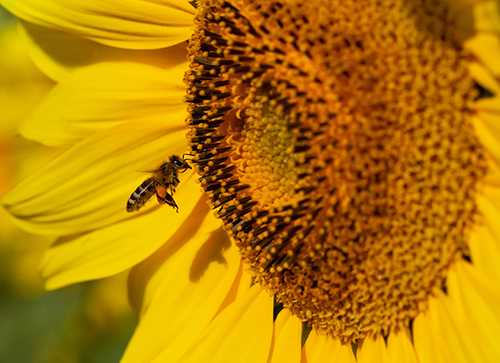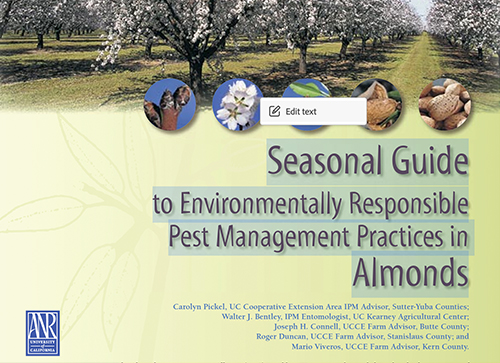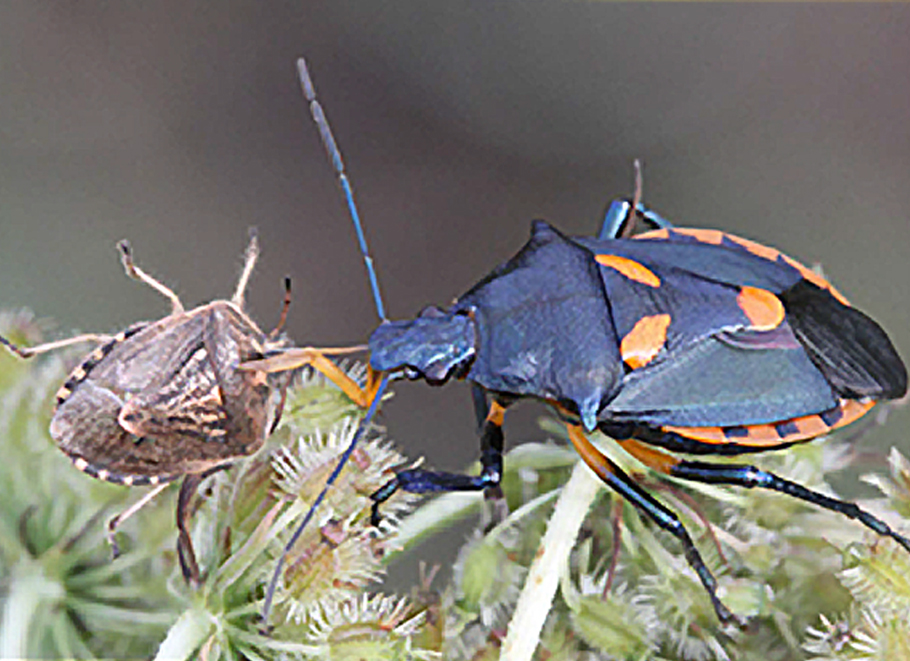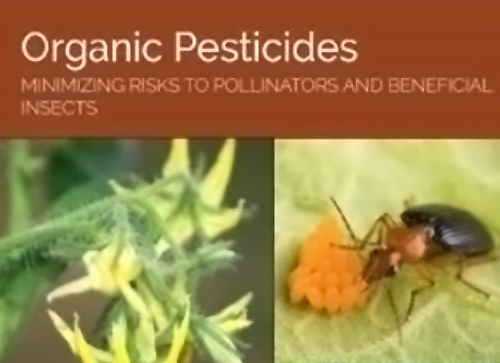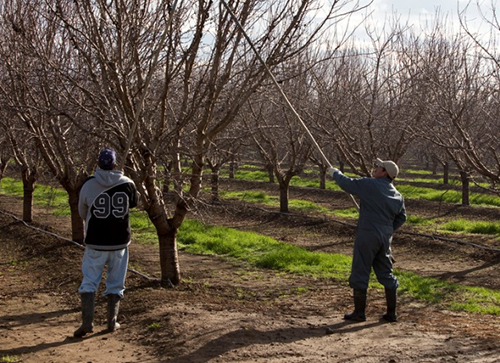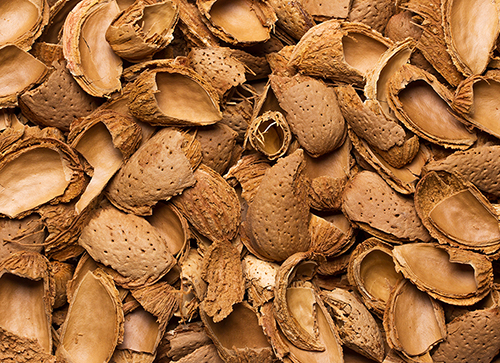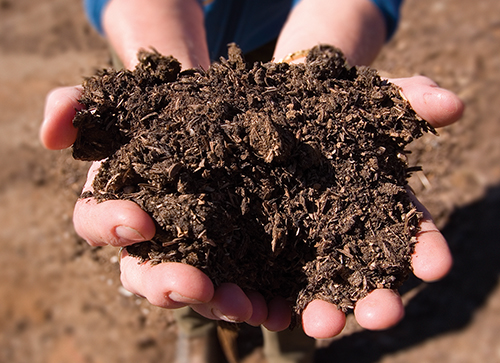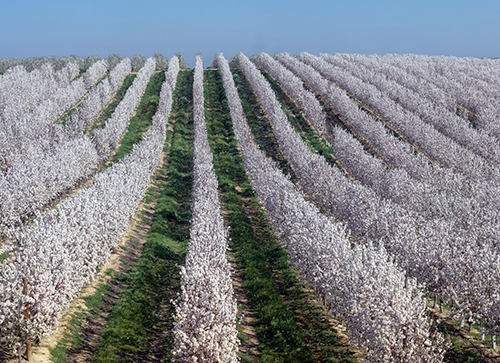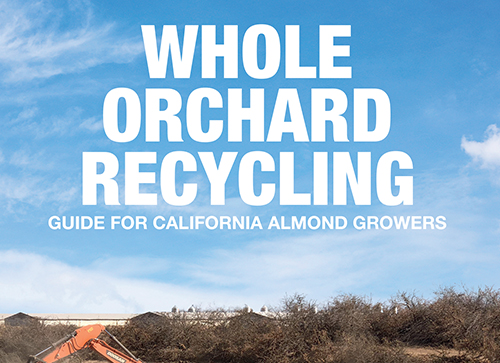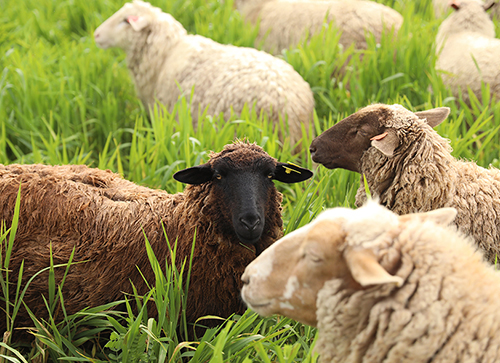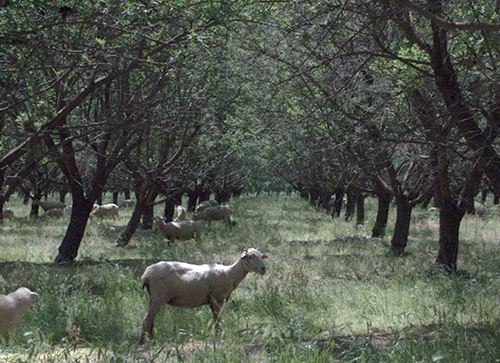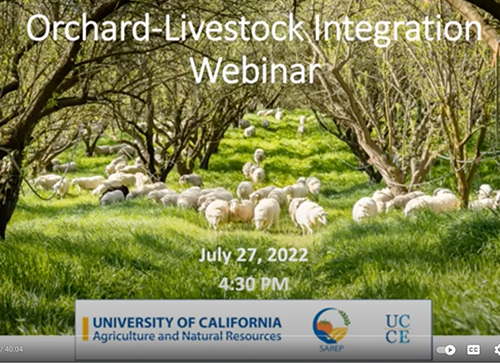
Regenerative Almond Production
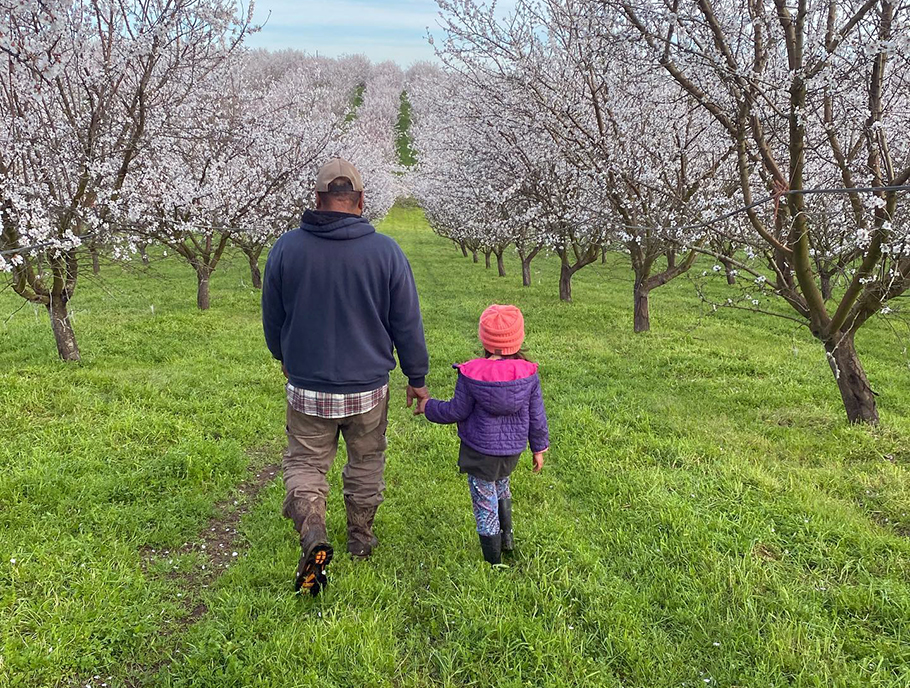 Almonds in bloom at Burroughs Family Farms
Almonds in bloom at Burroughs Family Farms
California is the largest producer of almonds in the world, contributing about 80% of the almonds grown today. They are California’s #1 agricultural export. That means that the choices made on almond orchards in the state have a significant impact both on the health of the environment and on the local economy.
California farmers, of course, have a deep respect for the natural resources they depend on. However, in recent years producers have been facing increasing challenges with extreme weather events such as multiple-year droughts followed by unusually high rainfall with massive flooding that threaten farm security and profitability. To address these challenges, farmers may be needing to make different choices and many are turning to regenerative agriculture.
Regenerative approaches to food production emphasize the use of practices that improve soil health and water efficiency, increase biodiversity, and promote long-term sustainability. This benefits farmers in many ways, from reducing costs and improving yields to enhancing the resilience of their crops to changing environmental conditions.
This page aims to provide practical guidance for almond producers who are interested in adding regenerative practices. We have compiled the latest research on the most effective strategies and will be regularly updating our content to reflect new developments in the field. Our goal is to support you in having a successful, environmentally-sustainable, and profitable operation while contributing to the well-being of our communities and local, state, and national economy.
Guiding Principles
The concept of regeneration when it comes to farming refers to restoring the biological health of the land so the natural functioning of water, carbon, nitrogen and other cycles operate at optimum efficiency. In a well-functioning ecosystem, the natural interrelationships between plants, sunlight, and the biology and microbiology of the environment create a biodiverse landscape that feeds itself and keeps overly destructive forces in balance. The choices we make in agriculture inevitably disturb that balance, in particular by destroying the beneficial microbes and insects that would otherwise assist with soil health, nutrient management, pollination, and pest control. It requires learning, time and effort to regenerate the biology and health of the soil; but it can improve significantly in just a few years and the long-term benefits can be extremely worthwhile. According to a recent study comparing regenerative and conventional almond production in California(opens in new window), regenerative systems had greatly improved soil health and biodiversity and created twice as much profit than their conventional counterparts.
The actual regenerative practices that an individual orchard might choose to implement will vary based on specific goals and local conditions. However, the basic principles are:
- Keep the soil covered
- Minimize soil disturbance (no till or minimum till)
- Increase Diversity
- Keep living roots in the ground
- Integrate livestock when possible
The most successful growers combine multiple regenerative practices that work together for the best results.
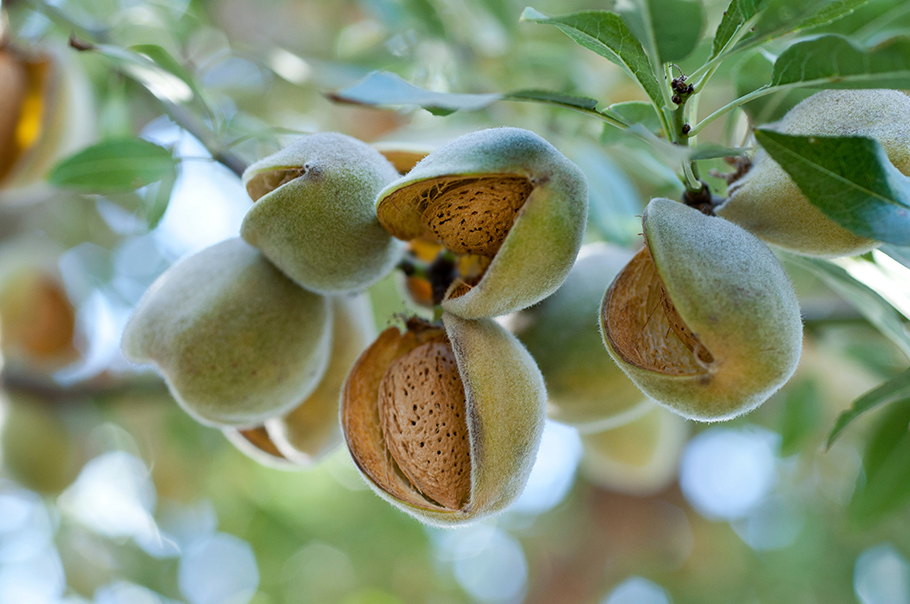 You’ll make more money.
You’ll make more money.
Many California almond growers find being pushed to change over to regenerative agriculture a bit frustrating and there are valid concerns driving that. This a hard time for the industry because of supply chain issues and drought, and it pays to be careful even in healthier economic situations. On the other hand, being overly cautious can keep you from making decisions that could make a big difference for your bottom line. [Click this box to learn more.]
CRARS Research on Regenerative Almond Production
"Impact of Compost and Multispecies Cover Crops on Almond Production and Soil Health" is an award-winning research project and presentation by Chico State graduate student and CRARS mentor-farmer Raquel Krach (Massa Organics). She received an Interdisciplinary Masters Degree with an emphasis on Regenerative Agriculture in Spring 2023.
Mentor Farmers Growing Almonds Regeneratively
Click on their photos to read firsthand accounts of what they've been doing, how it has been working for them, and what they advise for others.
Cover Crops and Pollinator Habitat
In many respects, using cover crops(opens in new window) can be thought of as the gateway to regenerative agriculture because they have long been used for soil health and to prevent soil erosion, and the benefits are well-documented. Choosing cover crops for specific purposes (such as adding nitrogen) is especially useful; but growing multiple species together often nets the best results as it allows you to increase diversity above and below ground and tackle multiple issues at once. However, even just allowing the native grasses and other vegetation to grow instead of keeping the ground bare can be helpful. If you choose to employ pollinator-friendly cover crops along with other pollinator-friendly practices, the benefits multiply immensely because bees and other pollinators are so important to almond production. Financial and technical assistance is readily available so this is a great place to start.
Creating pollinator habitat along the perimeter of an orchard or in the form of hedgerows(opens in new window) can also be a useful investment. While pollinator-friendly cover crops in California can be grown in time to attract bees for bloom season, they need to be terminated or grazed in most cases before harvest. Having permanent pollinator habitat can attract and nurture pollinators year round, increasing the native population and reducing dependence on shipping in bees every year. They also increase carbon storage in the soil and add aesthetic beauty that both the grower and local community can enjoy.
This video documents Elias Cosio, an almond grower from near Modesto who has been collaborating with NCAT and NRCS as he plants the first cover crop in his orchard with help from USDA, NCAT Agriculture Specialists Marisa Alcorta and Rex Dufour.
This video by SARE is entitled "Manage Weeds" but it is really about cover crops. Successful regenerative almond growers Benina Montes and Nick Hibma of Burroughs Faily Farms go into great detail about how they do it. An important piece is about when they choose to plant cover crops and when they simply allow the grass and native vegetation to grow.
In this NRCS video shot in Butte County (Durham, CA), Soil Conservationist Rachael Morgan discusses the role of pollinators in California agriculture and the importance of creating habitat to support the native pollinators that are dwindling in population and can help support the farmer in return.
Pollinator-Friendly Practices
It is a mistake to spend time, money, and effort growing pollinator-friendly cover crops and creating pollinator habitat without using practices that protect your investment. You don't want to invite bees and other beneficial insects into your orchard and then kill them. Avoiding pesticides by preventing infestation is best; however, in the early stages of transition and sometimes at other times, it may be impossible to avoid pesticides entirely. In particular, it is important to refrain from using pesticides during bloom season, to avoid products that are known to be toxic to bees, and to keep your permanent pollinator habitat on the perimeter of the orchard a pesticide-free zone. Mow or graze cover crops within the perimeters of your orchard before any insecticide use to encourage bees and other pollinators to leave the area, avoid spraying when conditions would create pesticide drift outside the interior of the orchard, and take pains to limit your pesticide use to only what is most necessary. Most regenerative growers greatly reduce or eliminate the use of pesticides over time. Cover crops and pollinator habitat can help attract beneficial insects that keep predators in check. Some growers will deliberately introduce beneficial insects or use organic dormant sprays and other biological controls.
Compost, Mulch, and Whole Orchard Recycling
Soil amendments such as compost and mulch are ways to both keep the soil covered and add important nutrients and organic matter that can build soil fertility and improve the structure and functioning of the soil. In particular, as these materials break down, they feed and improve the diversity of microbes in the soil. The easiest way to do this is to roller-crimp or mow the cover crops and allow the crop residue to remain on the ground. But you can also add compost or other soil amendments if desired.
There is also recent research that shows that whole-orchard recycling may be a good choice for creating an effective mulch and soil amendment. This process entails grinding or chipping old trees when they are removed instead of burning them. The product is then incorporated into the topsoil in the orchard. Researchers found that, while it did cost more to implement, the long-term benefit in terms of increased yield and soil health, farm resilience, and carbon sequestration was well worth it. Benefits were seen in as little as one year. Plus there are multiple funding sources available to help offset the cost.
Animal Integration
Adding animals to an almond orchard may seem problematic, but regenerative growers who plant cover crops frequently use animals to graze the cover crops or grass and add manure. Grazing improves soil fertility by increasing soil microbial density and organic matter. The animals press the plant residue and manure into the soil with their hooves, and eliminate the need to mow, roller-crimp, or otherwise terminate the ground cover before it goes to seed. Many growers like having the additional income stream that comes from adding animal products to an operation. Others might make an arrangement with a nearby grazier who also agrees to handle fencing and move the animals in a prescribed manner.
Regardless of benefit, though, it is true that adding animals does require more thought and preparation. Uncomposted manure poses potential health problems that cannot be ignored, and many certification bodies require that manure not be applied within 120 days of harvest time so the nuts are not contaminated when shaken to the ground. With newer methods of harvesting, such as using catch frames(opens in new window), nuts need not touch the ground and come into contact with manure; but the regulations still exist. That means that animals are only in the orchards in the winter and need to be moved to another location after that. There is also the need to keep the animals moving through the orchard so the crops are not overgrazed. Most regenerative operations use temporary electric fencing to keep the animals in only specific areas at a time, and they move the fencing to create a new paddock every few days or more often.
Research
DeVincentis A, Solis S, Rice S, Zaccaria D, Snyder R, Maskey M, Gomes A, Gaudin A, Mitchell J. (2022). Impacts of winter cover cropping on soil moisture and evapotranspiration in California's specialty crop fields may be minimal during winter months. Calif Agr 76(1):37-45. https://doi.org/10.3733/ca.2022a0001(opens in new window).
Fenster, Tommy L.D.; Oikawa, Ptricia Y.; and Lundgren, Jonathan G. (August 2021). Regenerative Almond Production Systems Improve Soil Health, Biodiversity, and Profit, Frontiers in Sustainable Food Systems. https://doi.org/10.3389/fsufs.2021.664359
Hodson, Amanda K., Jordan M. Sayre, Maria C. C. P. Lyra, and Jorge L. Mazza Rodrigues. (2021). "Influence of Recycled Waste Compost on Soil Food Webs, Nutrient Cycling and Tree Growth in a Young Almond Orchard" Agronomy 11, no. 9: 1745. https://doi.org/10.3390/agronomy11091745
Klein, A.-M., Brittain, C., Hendrix, S.D., Thorp, R., Williams, N. and Kremen, C. (2012), Wild pollination services to California almond rely on semi-natural habitat. Journal of Applied Ecology, 49: 723-732. https://doi.org/10.1111/j.1365-2664.2012.02144.x
Lepsch, Hannah C.; Brown, Patrick H.; Peterson, Caitlin A.; Gaudin, Amélie C.M.; Khalsa, Sat Darshan S. (2019). Impact of organic matter amendments on soil and tree water status in a California orchard, Agricultural Water Management, https://doi.org/10.1016/j.agwat.2019.06.002.
Medic, Ana; et all. "Benefits of Cover Cropping Systems in Walnut Orchards as Sustainable Agricultural Practice Sustainable Agricultural Practice,(opens in new window)" The CSU Journal of Sustainability and Climate Change. Volume 1 The CSU Journal of Sustainability and Climate Change: Conference Proceedings, 2021.
Omeg, Mike; "Improving Orchard Management through Multi-Species Cover Crop Mo(opens in new window)," Final report for FW14-019, SARE Sustainable Agriculture Research and Education Projects.
Saunders, Manu & Luck, Gary & Mayfield, Margaret. (2013). Almond orchards with living ground cover host more wild insect pollinators. Journal of Insect Conservation. 17. 10.1007/s10841-013-95846. https://www.researchgate.net/publication/256422481_Almond_orchards_with_living_ground_cover_host_more_wild_insect_pollinators(opens in new window)
Villa, Y.B., Khalsa, S.D.S., Ryals, R. et al. (2021). Organic matter amendments improve soil fertility in almond orchards of contrasting soil texture. Nutr Cycl Agroecosyst 120, 343–361. https://doi.org/10.1007/s10705-021-10154-5(opens in new window)

